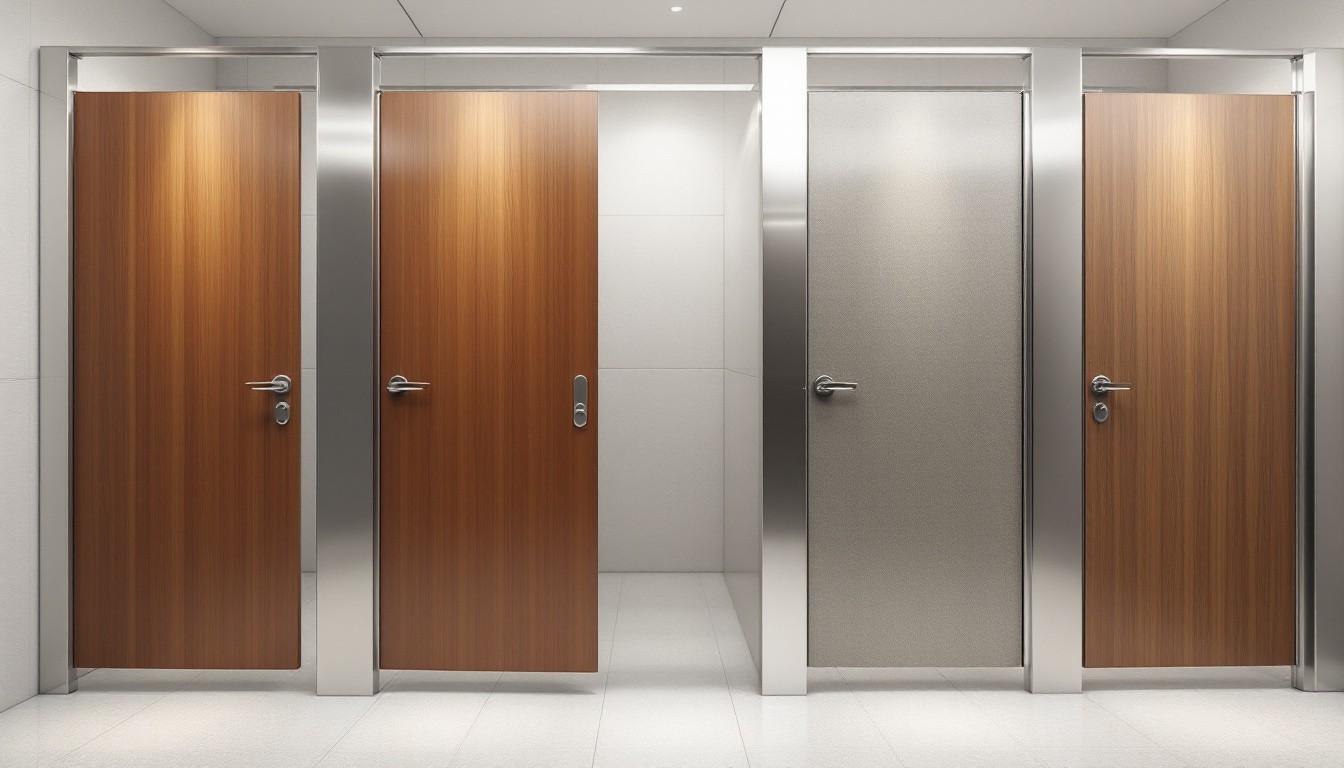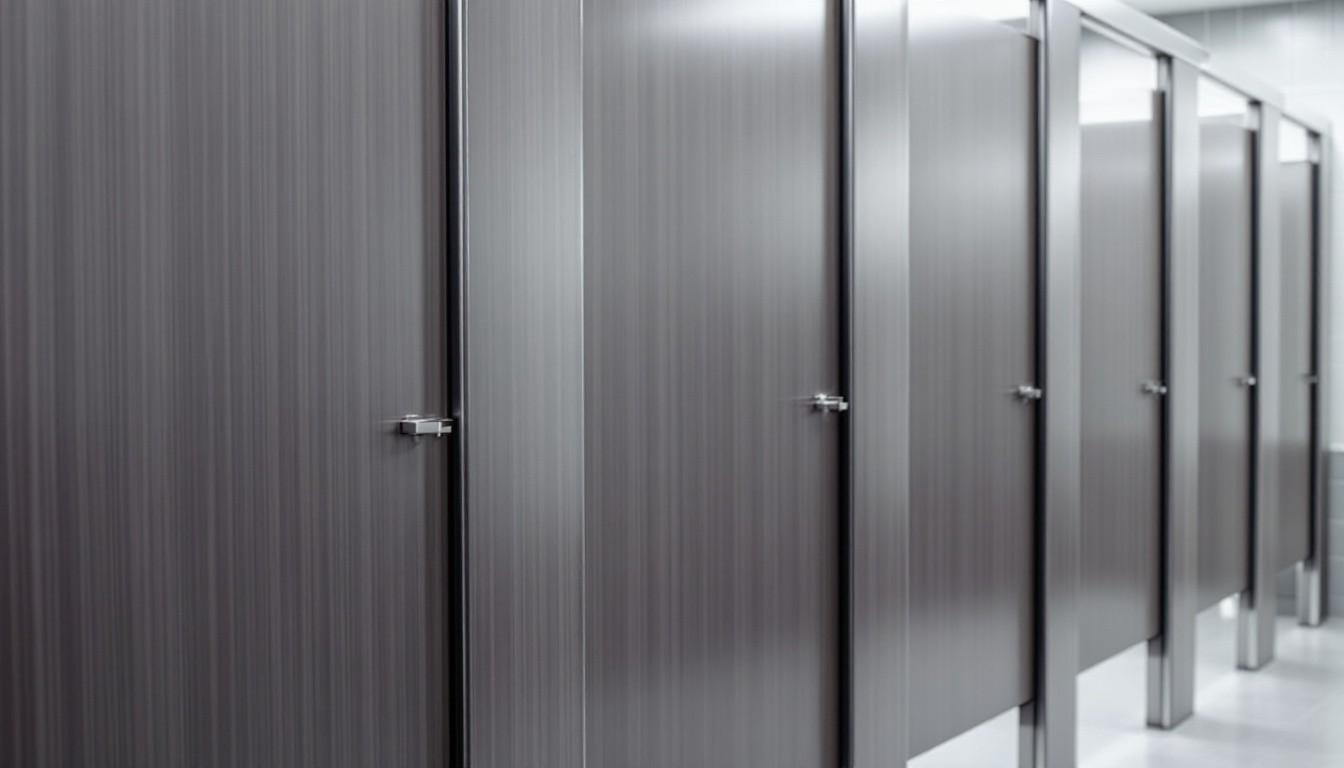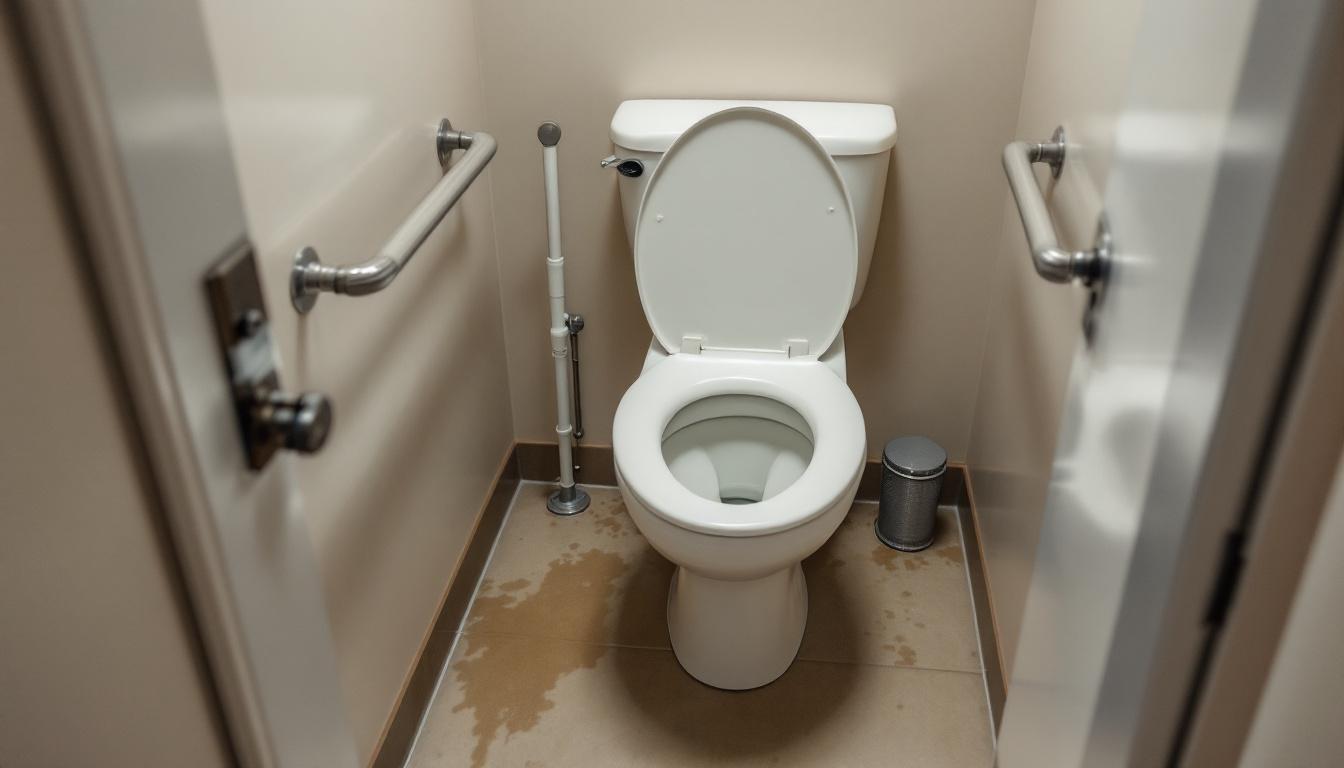Commercial bathroom stalls are a vital component of any public restroom. They provide privacy, comfort, and functionality for users while reflecting the overall design and quality of a business establishment.
At Partition Stalls, we understand the importance of selecting the right bathroom partitions for your commercial space. This guide will explore the various types, designs, and benefits of commercial bathroom stalls to help you make an informed decision for your facility.
Types of Commercial Bathroom Stalls
Commercial bathroom stalls are essential components of public restrooms, providing privacy and functionality for users. At Partition Stalls, we offer a range of options to suit various needs and environments. Let’s explore the main types of commercial bathroom stalls:
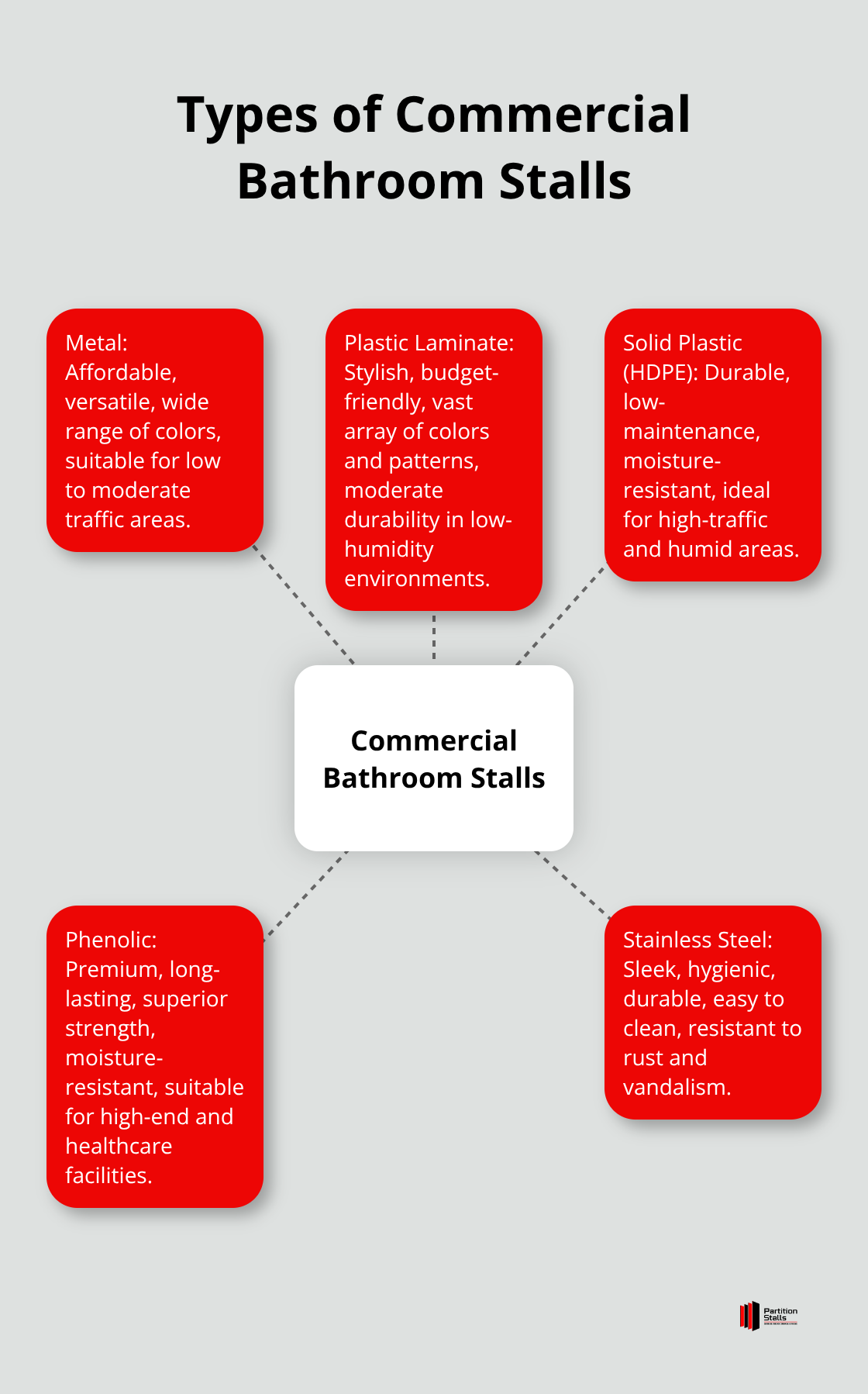
Metal Partitions: Affordable and Versatile
Metal partitions, typically made from powder-coated steel, offer a cost-effective solution for many commercial settings. These partitions provide:
- A wide range of color options
- Suitability for low to moderate traffic areas
- Ideal use in office buildings or retail stores
However, metal partitions have lower resistance to moisture and may show wear in high-traffic areas.
Plastic Laminate: Stylish and Budget-Friendly
Plastic laminate partitions strike a balance between affordability and aesthetics. They feature:
- A vast array of colors and patterns
- Creative design possibilities
- Moderate durability in low-humidity environments
These partitions work well in areas with moderate traffic, such as restaurants or schools. However, their particleboard core makes them vulnerable to moisture damage.
Solid Plastic (HDPE): Durable and Low-Maintenance
High-Density Polyethylene (HDPE) partitions excel in challenging environments. They offer:
- Durability and moisture resistance
- Low maintenance requirements
- Long-term value
- Suitability for high-traffic areas and humid locations
HDPE partitions are ideal for gyms, pools, and outdoor facilities where durability is paramount.
Phenolic Partitions: Premium and Long-Lasting
Phenolic partitions, made from compressed paper and resin, provide superior performance. They boast:
- Superior strength and heavy-duty qualities
- Moisture resistance and hygienic properties
- Excellent suitability for high-end facilities and healthcare settings
These partitions offer a premium solution for environments that demand top-tier hygiene and longevity.
Stainless Steel: Sleek and Hygienic
Stainless steel partitions combine modern aesthetics with practical benefits. They feature:
- A sleek, upscale appearance
- Excellent durability and ease of cleaning
- Resistance to rust and vandalism
- Superior hygienic properties
These partitions are perfect for upscale restaurants, hotels, or any facility aiming for a premium look and feel.
When selecting commercial bathroom stalls, consider factors like traffic volume, moisture levels, aesthetic requirements, and budget. Each partition type offers unique strengths, and the right choice depends on your specific needs. The next section will discuss important design considerations to help you make an informed decision for your commercial restroom.
How to Design Effective Commercial Bathroom Stalls
Prioritizing Privacy
Privacy stands at the forefront of bathroom design. We recommend taller partitions (ideally 72 inches high) to provide better coverage. Gap-free interlocking doors and pilasters eliminate sightlines, which enhances user comfort. Floor-to-ceiling partitions offer ultimate privacy and have gained popularity in high-end establishments.
Ensuring ADA Compliance
ADA compliance is a must in commercial bathroom design. The 2010 Standards set minimum requirements for newly designed and constructed or altered State and local government facilities. Standard accessible stalls should measure at least 60 inches wide and 59 inches deep. When six or more toilet compartments are provided, ambulatory accessible stalls (35-37 inches wide) become necessary in addition to standard accessible stalls. The inclusion of grab bars and proper door clearance is essential.
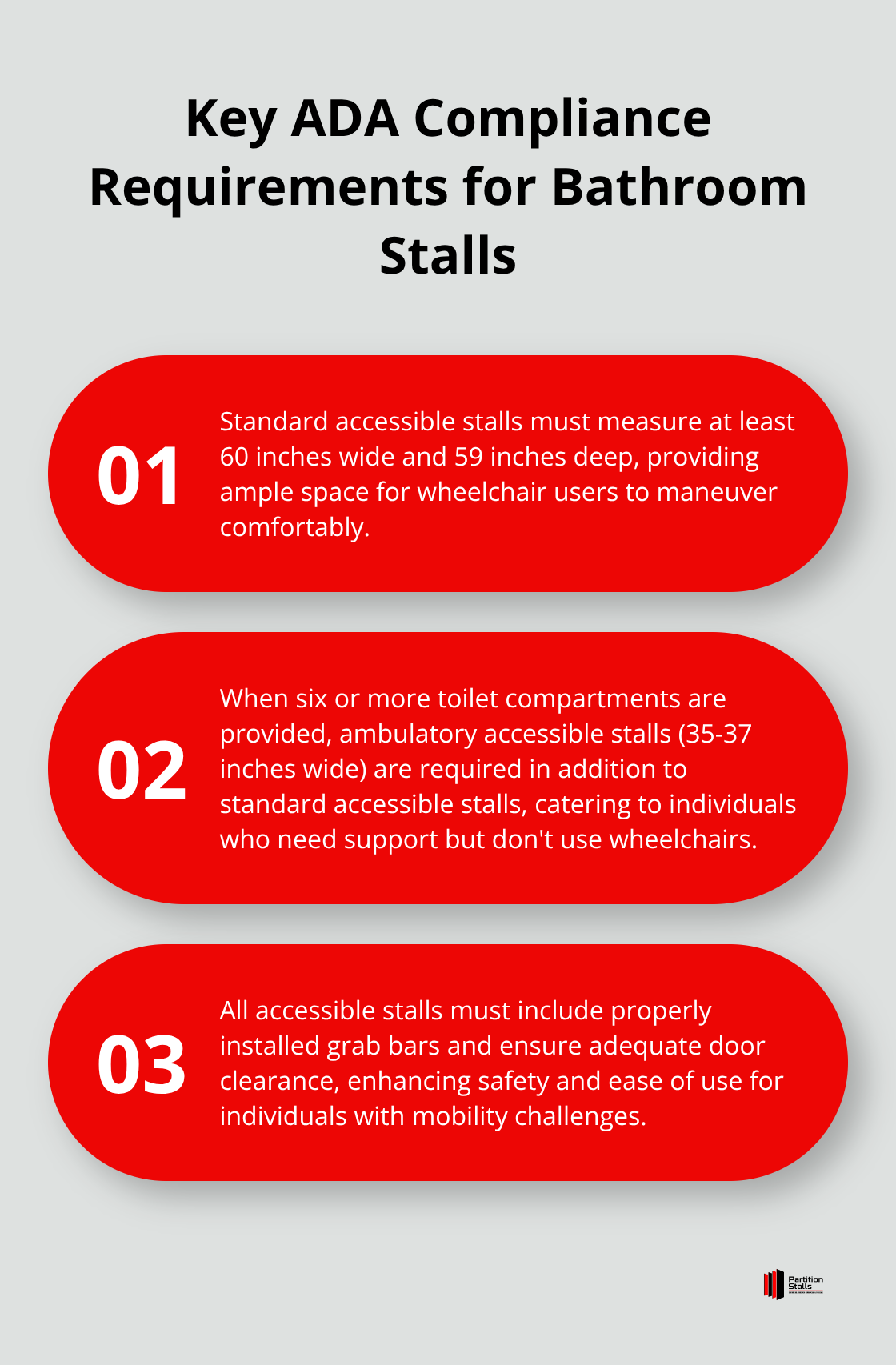
Balancing Durability and Maintenance
The selection of materials that withstand heavy use while remaining easy to clean is paramount. HDPE and phenolic partitions excel in this regard, as they resist scratches, dents, and graffiti. These materials also stand up to moisture and chemicals, which makes them ideal for high-traffic areas. Stainless steel hardware (including hinges and brackets) further enhances longevity and simplifies maintenance.
Aesthetic Appeal
The visual appeal of bathroom stalls contributes significantly to the overall impression of a facility. Modern designs often incorporate sleek lines, bold colors, and innovative materials to create an inviting atmosphere. Customizable options allow businesses to align their bathroom aesthetics with their brand identity. (The right combination of form and function can transform a utilitarian space into a memorable part of the user experience.)
Space Optimization
Material selection and layout design are crucial factors in creating high-end commercial bathroom stalls and partitions. Compact yet comfortable stall layouts maximize the number of units without compromising user comfort. Careful consideration of door swing paths and circulation space can significantly improve the overall flow and functionality of the restroom. Overhead-braced or floor-to-ceiling mounted partitions can create a more open feel, even in smaller spaces.
The design of commercial bathroom stalls impacts both user experience and facility management. A focus on privacy, accessibility, durability, aesthetics, and space utilization results in bathroom stalls that meet functional and visual needs. The next section will explore the numerous benefits that high-quality commercial bathroom stalls bring to businesses and their patrons.
Benefits of High-Quality Commercial Bathroom Stalls
Enhanced Hygiene and Sanitation
High-quality commercial bathroom stalls significantly improve hygiene in public restrooms. Materials like HDPE and phenolic resist bacteria growth and are easy to sanitize. This resistance reduces the spread of germs and protects users’ health. Having soap dispensers readily available and fully stocked is vital to promoting good commercial bathroom hygiene. Keeping hands clean creates a healthier environment for all users.
Improved User Experience
The quality of restroom facilities can profoundly impact a customer’s overall impression of a business. High-quality stalls with features like gap-free doors and robust construction provide the privacy and comfort users expect. A survey conducted by the Bradley Corporation revealed that almost 60% of respondents believe an unclean restroom shows poor management, 56% are left with a tarnished opinion of the business, and half vow not to return. Premium stalls contribute to higher satisfaction rates and increased customer loyalty.
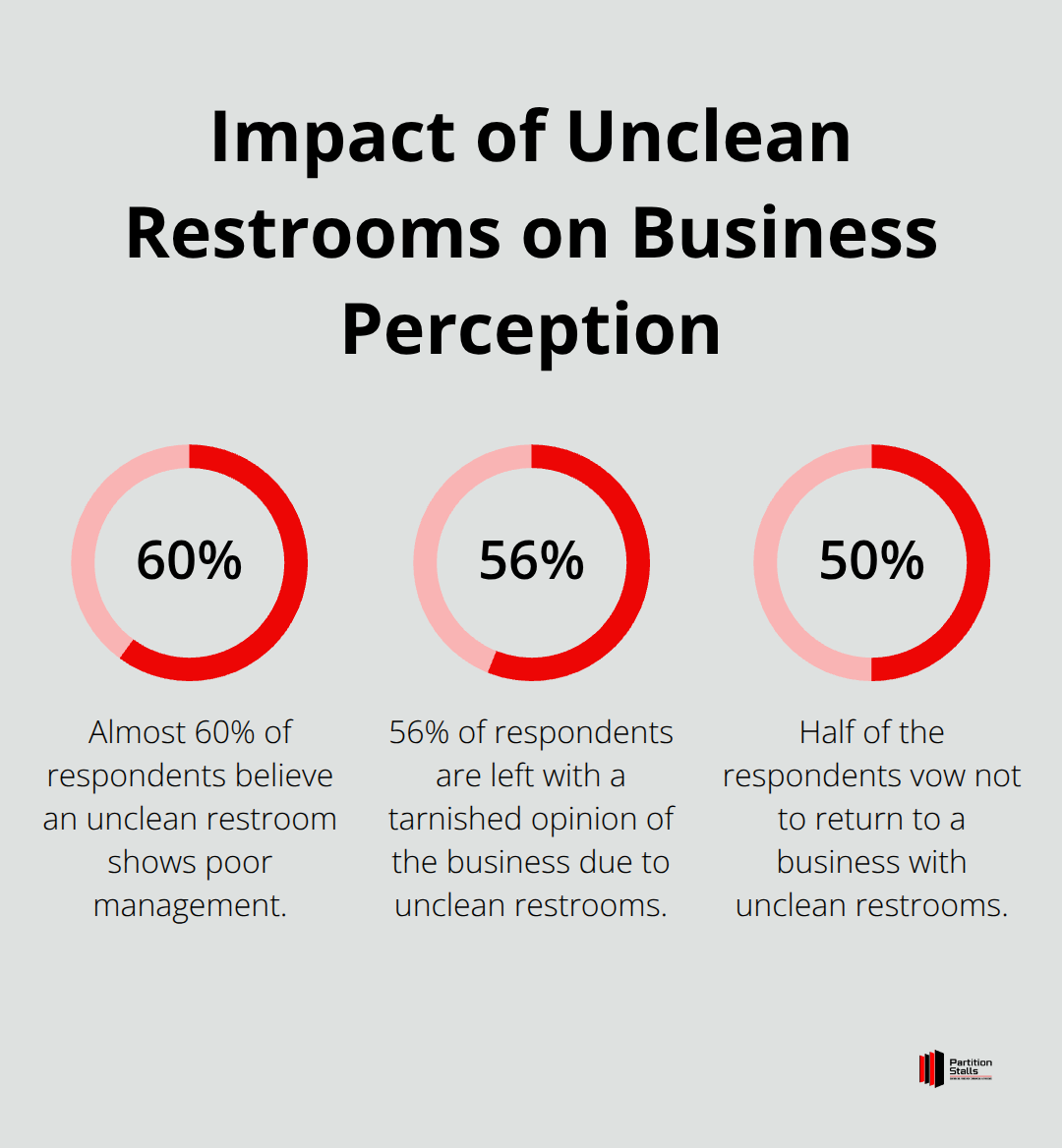
Cost-Effectiveness Over Time
While premium stalls may require a higher initial investment, they offer substantial long-term savings. For instance, HDPE partitions can last up to 25 years with minimal maintenance, compared to 5-10 years for standard metal partitions. This longevity translates to fewer replacements and repairs over time. Durable materials also resist vandalism and wear, further reducing maintenance costs.
Positive Impact on Business Reputation
High-quality bathroom stalls contribute to a positive business image. Clean, well-maintained restrooms reflect a company’s commitment to customer care and attention to detail. This attention can lead to positive word-of-mouth recommendations and improved online reviews. Businesses that invest in superior restroom facilities often see an increase in customer satisfaction and loyalty.
Environmental Sustainability
Many high-quality commercial bathroom stalls are made from sustainable materials. Solid plastic toilet partitions include exceptional durability, resistance to moisture and impact, low maintenance requirements, and enhanced sustainability. This sustainability factor aligns with growing consumer preferences for environmentally responsible businesses. Companies that choose eco-friendly restroom solutions can reduce their environmental footprint and appeal to environmentally conscious customers.
Final Thoughts
Commercial bathroom stalls play a significant role in any business or facility. The right choice impacts durability, maintenance, and user experience, while design considerations create effective restroom spaces. High-quality stalls improve hygiene, elevate user experience, and prove cost-effective over time.
We at Partition Stalls offer expertise in providing restroom solutions tailored to various settings. Our commitment to customer satisfaction makes us an ideal partner for transforming your restroom facilities. We provide durable partitions and ergonomic accessories for offices, gyms, restaurants, and public facilities.
Quality commercial bathroom stalls represent an investment in your business’s image and operational efficiency. Careful consideration of options and partnership with experienced professionals can create restroom spaces that meet functional needs and enhance overall facility experience. A well-designed restroom demonstrates attention to detail and commitment to customer care.


